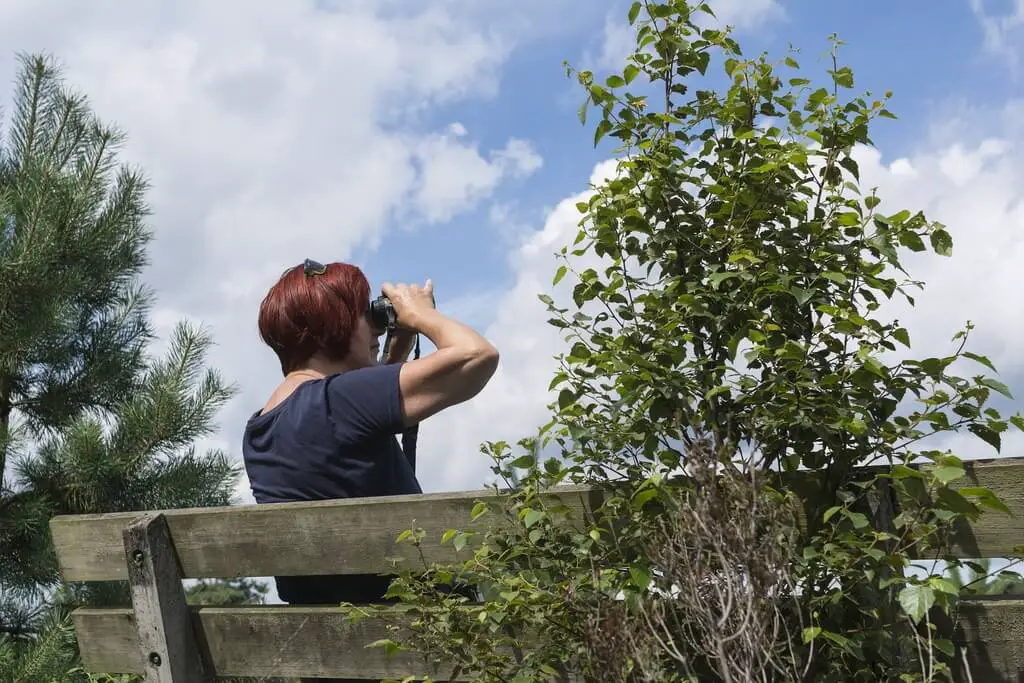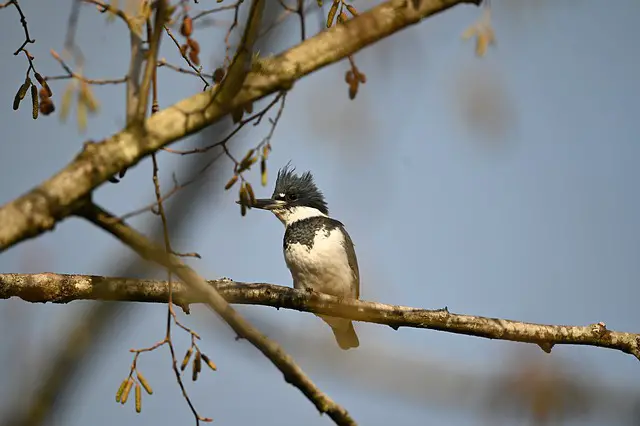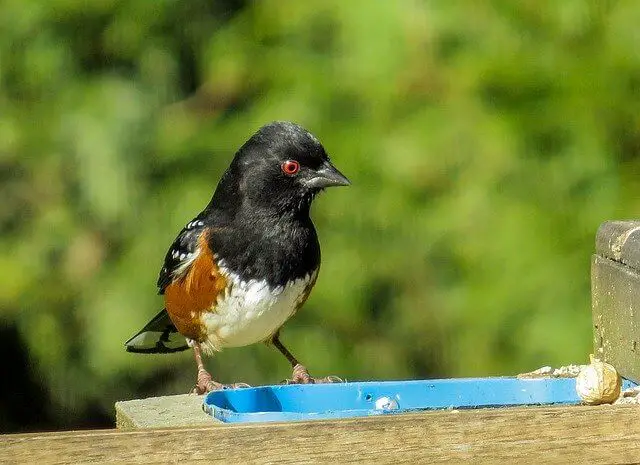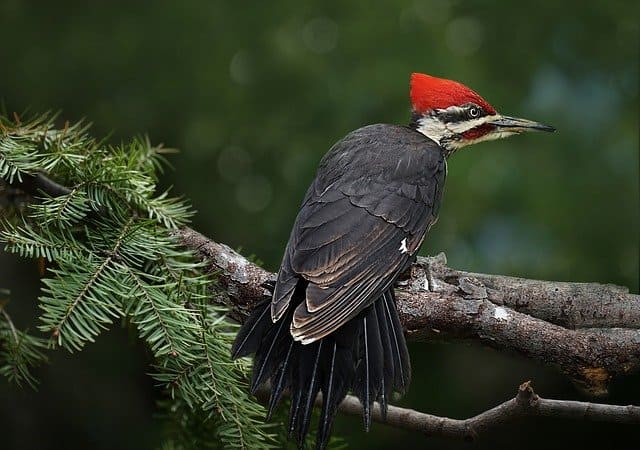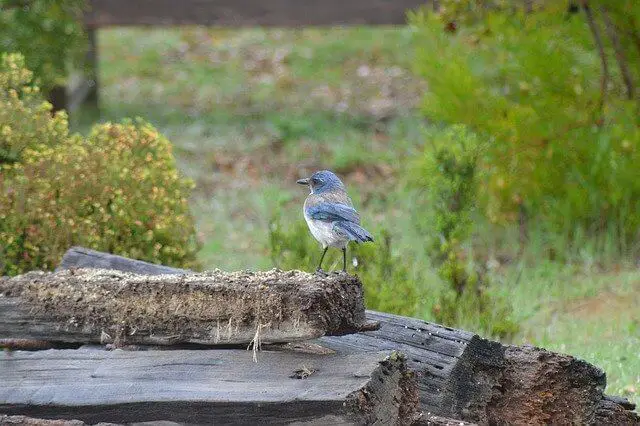Embark on a journey through Washington State’s diverse landscapes with our expert guide to the 26 most common bird species! From the iconic Red-breasted Sapsucker to the charming Black-capped Chickadee, Washington’s forests, mountains, and coastal regions host a rich array of avian life.
In this comprehensive guide, we’ll uncover the unique characteristics, habitats, and behaviors of each species, offering valuable insights for bird enthusiasts and nature lovers alike.
Table of Contents
- 1 Most Common Birds of Washington State
- 1.1 American Robin
- 1.2 American Crow
- 1.3 Song Sparrow
- 1.4 Red-Breasted Sapsucker
- 1.5 Killdeer
- 1.6 Golden-crowned Kinglet
- 1.7 Belted Kingfisher
- 1.8 House Sparrow
- 1.9 Spotted Towhee
- 1.10 European Starling
- 1.11 Black-Capped Chickadee
- 1.12 Chestnut-backed Chickadee
- 1.13 Pacific Wren
- 1.14 Dark-Eyed Junco
- 1.15 Red-Breasted Nuthatch
- 1.16 American Goldfinch
- 1.17 Northern Flicker
- 1.18 Pileated Woodpecker
- 1.19 Hairy Woodpecker
- 1.20 Rufous Hummingbird
- 1.21 American Kestrel
- 1.22 Steller’s Jay
- 1.23 California Scrub-Jay
- 1.24 Calliope Hummingbirds
- 1.25 Black-chinned Hummingbird
- 1.26 Anna’s Hummingbird
- 2 Frequently Asked Questions
- 3 Author
Most Common Birds of Washington State
American Robin
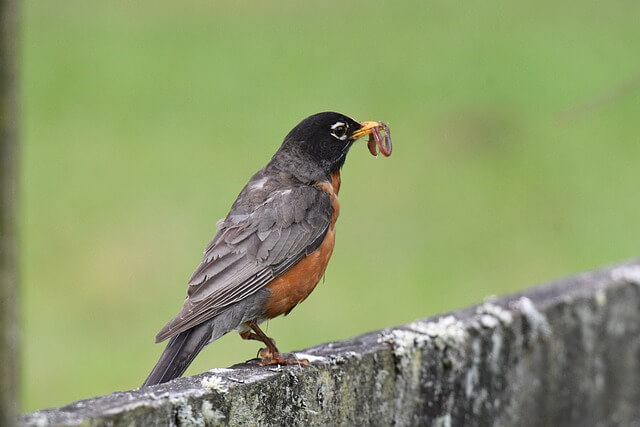
The American Robin is a migratory songbird that breeds in the eastern United States and Canada. They are known for their red breast, black head and yellow bill.
Their range includes southern Alaska, Newfoundland, the West Indies, Mexico and Central America. The species’ habitat ranges from grasslands to forests, scrubby fields to suburban backyards.
They eat insects such as beetles and caterpillars, as well as berries like juniper or elderberry when they are available. Their migration pattern can be confusing because some birds travel north for winter while others head south.
Related Post: Interesting American Robin Fun Facts
American Crow
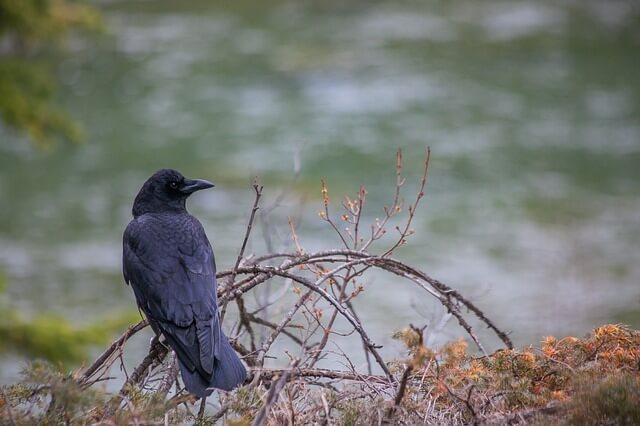
American Crows are a migratory bird that range from the northernmost parts of Canada to Central America. Their habitats include forests, agricultural fields, coastal areas and parks.
These birds are omnivores and feed on everything from fruit, insects, small mammals, earthworms and frogs. They have also been known to eat carrion and garbage in urban areas.
American Crows spend their winters as far south as South America but return north each spring for breeding season where they nest in trees or man-made structures such as buildings or bridges.
Related Posts:
Song Sparrow

The song sparrow is a small brown bird, about 5″ inches long. It’s common to see them in backyards and near streams throughout the United States.
The song sparrow’s range includes most of North America, but it prefers to live on the east coast and parts of the south. Song Sparrows prefer grassy areas for feeding and nesting, including marshes, meadows, open fields or roadsides with tall grasses.
These birds feed mainly on insects such as ants, flies, beetles, caterpillars and grasshoppers, although they will occasionally eat seeds, and berries from plants like blackberries, elderberry.
Related Post: Birds That Look Like Sparrows
Red-Breasted Sapsucker
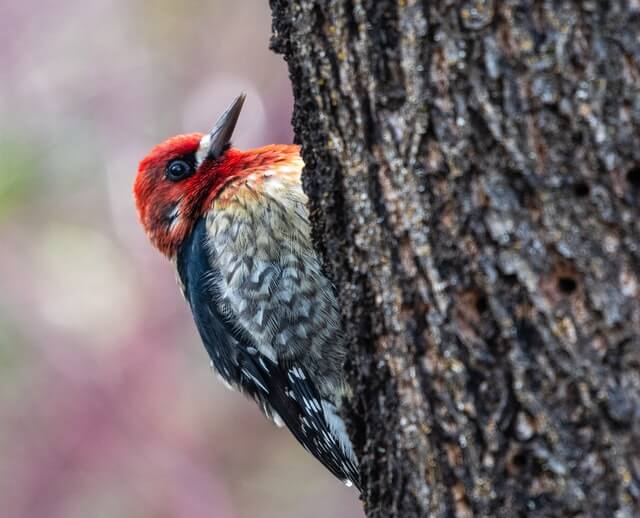
The red-breasted sapsucker bird is a migratory bird that ranges from the United States to Canada. The habitat of this species includes moist woodlands, mixed forest and suburban areas with trees or shrubs.
They have also been found in semi-arid forests, but only during winter months, when they were feeding on insects. Red-breasted sapsuckers feed on tree sap as well as insects, which are usually caught by probing into bark crevices and drilling holes in trees to get at the sap that’s inside.
Sapsuckers have strong legs with sharp claws that allow them to cling to vertical surfaces, so they can extract the sap from small holes in trees where it pools.
Related Post: Sapsucker Bird Facts Explained
Killdeer
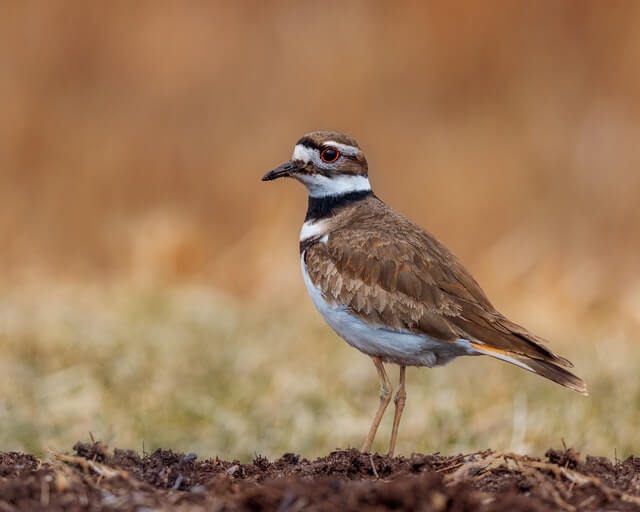
The Killdeer Range is located in southwestern Manitoba, southeastern Saskatchewan and northern North Dakota. This area has a vast prairie grassland that offers ideal nesting grounds for the killdeer to raise their young.
The range also provides plenty of food sources including insects, rodents, reptiles and plants such as clover or dandelions. Killdeers migrate during the winter months from Canada to Texas because they are unable to survive at lower temperatures.
Killdeers prefer wet habitats and nest on open ground or shallow water near marshes, ponds, streams, or vernal pools. Females lay between 3-8 eggs at a time but usually only one chick survives due to predation by foxes and other animals.
Golden-crowned Kinglet
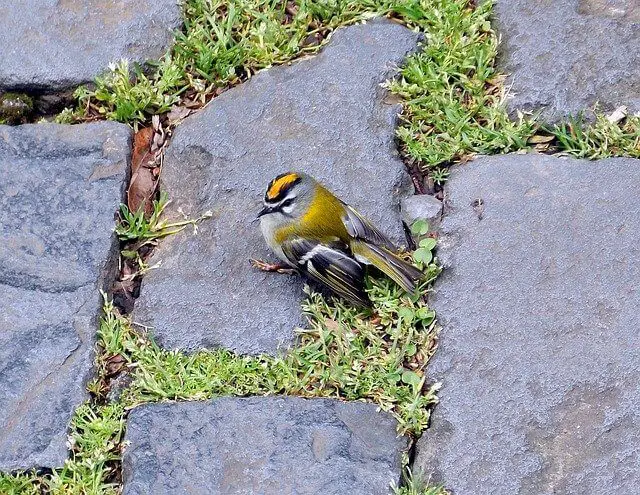
The Golden-crowned Kinglet is a small songbird. The bird can be found in North America from the Eastern Great Lakes to the Rocky Mountains, and it migrates south for winter. The Golden-crowned Kinglet lives mostly in forests of coniferous trees such as pine, spruce, fir and larch trees.
The Golden-crowned Kinglet’s habitat includes brushy forests, moist deciduous woods, mixed woodlands and coniferous swamps. They feed on insects, and other invertebrates like spiders, beetles, wasps and caterpillars.
Belted Kingfisher
Belted Kingfishers are birds that can be found in many areas of North America. Their range includes Canada, Mexico, the United States and Central America.
Kingfishers like to live near water such as rivers, freshwater, coastal habitats and even mangrove swamps or lakes but will also settle in areas that provide adequate vegetation for cover.
Kingfishers usually eat small fish or other aquatic animals such as crayfish or frogs. They may also hunt insects on land if they cannot find any aquatic prey nearby.
House Sparrow

The House Sparrows are native to North America and migrate in the spring, summer, and fall. They range from Mexico to Canada, but spend their winters along the coast of southern California.
They can be found in urban areas as well as rural ones; they like woodlands with trees or shrubs near streams or rivers. Their diet is very varied, as they do not eat only insects.
They also will eat small birds, worms, slugs, frogs, snails, carrion, and other small animals. They also like fruits, berries, seeds, nuts, vegetables, seeds, and meat.
Related Post: How to Attract Sparrows to your Backyard
Spotted Towhee
The Spotted Towhee is a common bird found in North America. The habitat of the spotted towhee varies depending on the season and their range spans from northern Canada to southern Mexico.
In winter, they can be found in open areas with scattered trees such as farmland, shrubland or forest edges, while during summer months they are more likely to inhabit woodlands.
The diet of the spotted towhee consists mainly of seeds and insects; however, it will also eat nuts and berries.
Related Post: How to Attract Towhees to your backyard?
European Starling
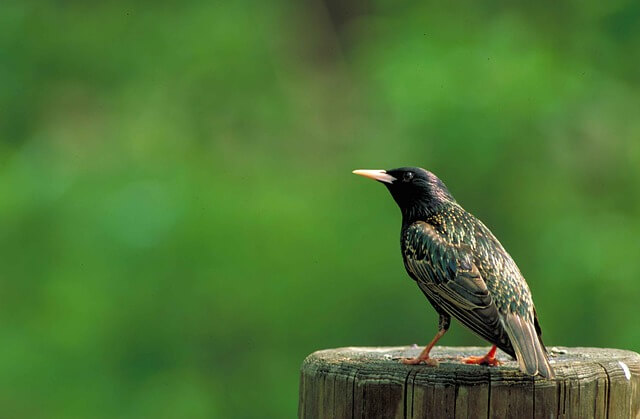
The European Starling, also sometimes referred to as the common starling of the U.S. or just the common starling of the British Isles, is actually a medium-sized passerine bird in the passerine family, Sturnida.
It is usually about eight inches long, similar to a robin, and has a black body with a metallic gleam, which often is speckled by white. Starlings feed mostly on insects, but it also feeds on small amphibians, seeds, berries, nuts, carrion, and other food items.
They feed throughout the year, but the most well known times are spring and summer. They inhabit areas that are close to water such as fields, parks, ponds, lakes, rivers and streams.
Related Posts: How To Attract European Starlings To Your Yard Fast?
Black-Capped Chickadee
The black-capped chickadee is a small songbird that can be found in most of North America. It has the ability to fly short distances and are very good at flying from tree to tree.
The black-capped chickadees have their breeding range from Alaska, Canada, Newfoundland, Quebec and Nova Scotia southward through New England and into Pennsylvania, West Virginia and Tennessee.
Their habitats include deciduous forests, mixed woodlands, suburban areas and even wetlands. These birds eat mostly insects such as caterpillars and ants, seeds from sunflowers or wildflowers, fruit (e.g., blackberries) and berries (e.g., elderberries).
Related Posts:
Chestnut-backed Chickadee
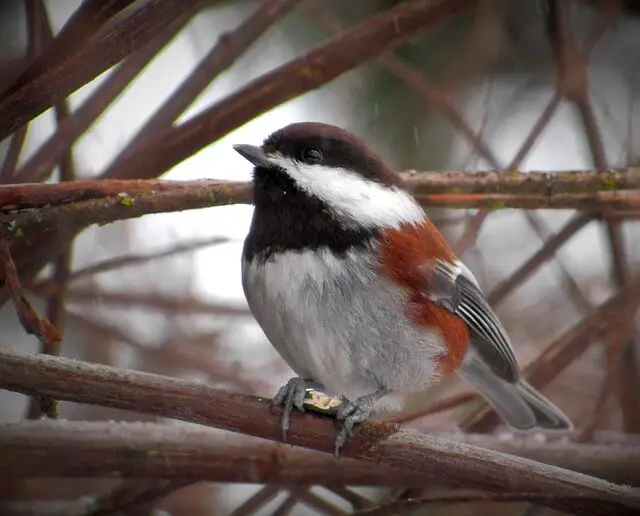
The Chestnut-backed Chickadee is a small bird found in the North American Eastern deciduous forest. They live primarily on nuts, seeds and insects that they find in the trees.
The Chestnut-backed Chickadee has a range from southern Canada to northern Florida with populations living mostly north of 40 degrees latitude.
The habitat is typically mixed hardwood forests, oak woodlands or coniferous forests and have been spotted as far south as Arizona
Related Post: How Do I Attract Chickadees To My Yard
Pacific Wren
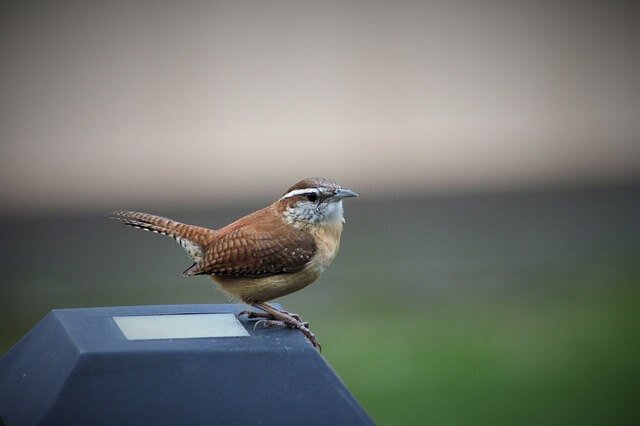
The Pacific Wren, a member of the wren family Troglodytidae. The Pacific Wren is a small bird that has a limited range and habitat. It’s known to inhabit the west coast of North America, from northern California to southern Alaska.
They are generally found in coniferous forests with dense undergrowth, including cedar trees and mixed evergreen forest. The wren prefers moist environments where they can find food such as insects and berries on shrubs or bushes near water sources.
Related Post: How to Attract Wrens to your Backyard
Dark-Eyed Junco

The Dark-eyed Junco is a small North American songbird. They are migratory and can be found in the boreal forests of Canada, Alaska, the Rocky Mountains and western United States during the summer months.
They live in mixed coniferous/deciduous forests with shrubs, as well as other open woodlands that provide scattered trees or brush piles for nesting sites. This bird feeds on invertebrates like spiders, beetles and ants that they find on leaves.
Related Post: Interesting Dark-eyed Junco Fun Facts
Red-Breasted Nuthatch
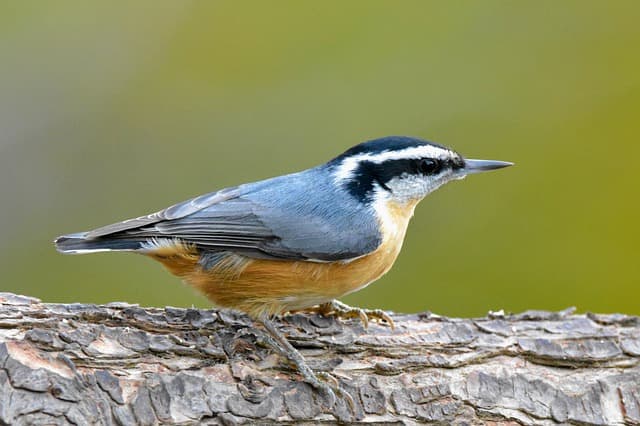
Red-breasted Nuthatches are small birds that have a red breast and white stripes on their sides of its head. They are mainly found in North America, with the range extending from eastern Canada to Mexico.
The nuthatch habitat is generally mixed woodlands and open country such as forest edges, farms, parks or gardens. These birds will eat anything they can find for food including seeds, nuts, insects and fruit.
Red-breasted Nuthatches migrate south during winter months to escape the
Related Post: How to Attract Nuthatches to your Backyard? Expert Tips!
American Goldfinch

The American Goldfinch is a common bird species found in North America. They are the smallest member of the finch family, but they still can be easily identified by their distinctive bright yellow and black coloration.
The range for this bird extends from northern Canada to southern South America. In the United States, these birds are only found in Alaska and parts of western coast states such as California, Oregon, Washington and some parts of New Mexico and Arizona.
American Goldfinches feed on seeds such as millet, wheat or rye from thistle plants, but also consume insects such as beetles, and crickets.
Related Post: American Goldfinch Interesting Facts
Northern Flicker
Northern Flickers are a medium-sized woodpecker that live in North America. They have a wide range and can be found in Northern Canada, most of the United States, and parts of Mexico. They are ground feeders that eat ants, beetle larvae, crickets, snails and spiders among other things.
The Northern Flicker’s habitat is a mix of dense forest patches and agricultural areas, especially on the eastern edge of its range where it can find more farmland than forest.
These birds migrate south for winter but return north again every spring.
Related Post: How to Attract Northern Flickers to your Backyard
Pileated Woodpecker
The Pileated Woodpecker is a medium-sized woodpecker that can be found in the eastern United States and Canada. They are mainly found on woodland edges, old growth forests, and mixed deciduous forests.
The range of this bird is mainly seen between Newfoundland to central New York, from Quebec to Georgia, Alabama and Mississippi. The pileated woodpeckers usually spend their time searching for food such as grubs under tree bark or eating fruits that have fallen from
They can be found in many wooded habitats in Washington State. Some woodpeckers live in large swaths of wooded land, and some woodpeckers prefer to nest in trees and bush, especially along river banks and swamps. However, the majority of woodpeckers spend their time in dense woods.
Related Post: How to Attract Pileated Woodpeckers to your Yard
Hairy Woodpecker
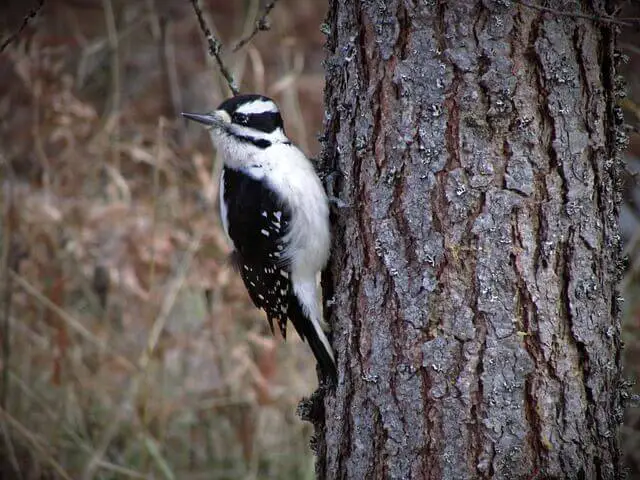
The Hairy Woodpecker is a North American bird that lives in the Eastern United States. The range of this woodpecker includes Florida, and it migrates to parts of Canada during winter.
Their habitat ranges from forests to woodlands to suburbs, where they will forage for food such as insects and nuts, but also eat sap from trees or peck at freshly planted seeds.
They prefer moist habitats near streams or rivers because these areas provide plenty of insects for food.
Rufous Hummingbird

The Rufous Hummingbird is a species of hummingbird found in the Western United States. The range for this bird spans from Southern California to Northwest Oregon and as far east as New Mexico.
These birds live mostly in mountainous regions, but have been seen living near coastal areas and desert oases. They typically feed on nectar from flowers, flowering trees, fruit or insects like flies and beetles.
Hummingbirds are migratory animals that travel north during the spring months.
Related Post: Where do Hummingbirds go in the Winter?
American Kestrel
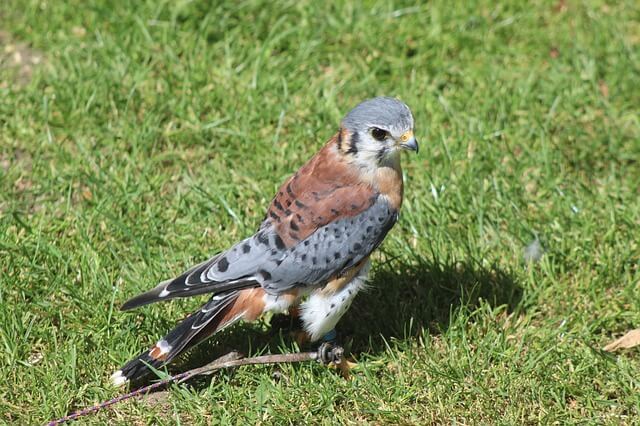
The American Kestrel is a small bird of prey that ranges from the eastern United States to Canada and south into Mexico. They are found in habitats such as forest, prairie, grassland, deserts and marshes. They are mostly known for their fast and agile flight
These birds mainly eat insects, but also hunt small mammals and reptiles. Their migration pattern varies depending on their location, but they will migrate to warmer climates during winter months or when food becomes scarce.
Related Post: 20 American Kestrel Fun Facts
Steller’s Jay
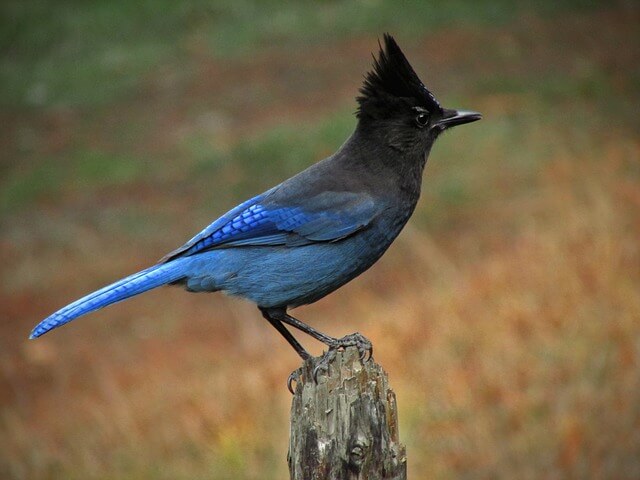
The Steller’s Jay is a very interesting bird that has been spotted in many places. They are found all over the United States and Canada, and they migrate to parts of Mexico.
Their habitat includes forests, shrublands, grasslands, parks, woodlots, suburban areas and occasionally deserts. They feed on a variety of things such as insects like beetles or ants; seeds from berries or plants; nuts like acorns, hazelnuts and also invertebrates.
The Jays will nest in tree cavities near their food sources such as oak acorns, pine nuts, juniper berries, and blueberries.
Related Post: How to Attract Steller’s Jay to your Yard – Expert Tips!
California Scrub-Jay
The scrub jay is a medium-sized bird that can be found in many areas of North America. They have a range that covers the southeastern United States and northern Mexico, with a population of about 4,000 individuals.
Scrub Jays are omnivores and their diet consists mainly of insects, berries, nuts and seeds. Their preferred habitat includes scrublands with dry shrubs or mixed pine forests near rivers or streams.
These jays usually travel alone and only come together during mating season for two weeks at a time before going back to solitary life styles again.
Calliope Hummingbirds
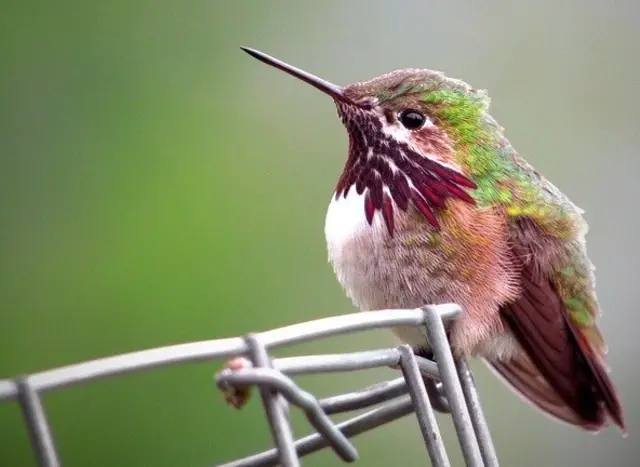
Calliope Hummingbirds are a migratory bird that can be found in many parts of North America. They are the smallest hummingbird in North America and their habitat is primarily along mountain ranges, deserts, coastal areas and also deciduous forests.
These birds feed on insects such as spiders, flies and beetles as well as nectar from flowers which they can reach by hovering close to them with their long tongues extended.
This species has one of the longest migration patterns, it winters in Central America, where it occupies pine forests from Costa Rica to Panama, and often nests close to palm trees or banana plants for shelter.
Related Post: 31 Flowers That Attract Hummingbirds (Photos, ID & Info!)
Black-chinned Hummingbird
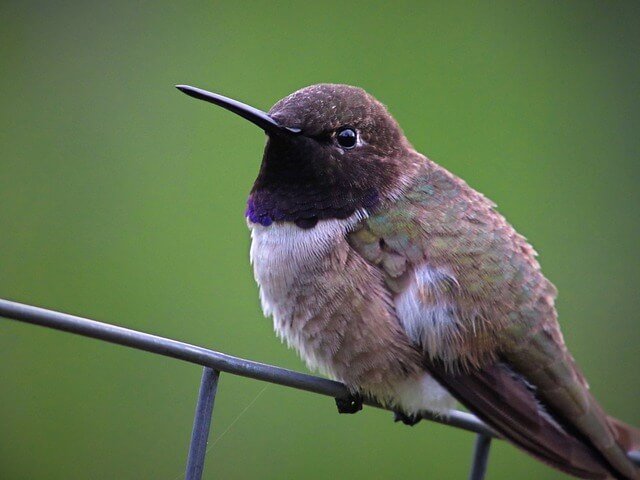
The Black-chinned Hummingbird is a small bird that breeds in western North America. They are typically found from the Rocky Mountains to the Pacific Coast, though they have been spotted as far east as Texas and Louisiana.
The bird lives in open woodland, desert scrub, thorn scrub, arid brushy country with large cacti or mesquite trees as well as mountainous areas below 10,000 feet altitude.
The Black-Chinned Hummingbird migrates from Canada to the United States during the winter months for food supply, but will return north once it is warm enough again.
Anna’s Hummingbird

Anna’s Hummingbird is a beautiful bird, with feathers of iridescent green and deep blue. Anna’s Hummingbirds are native to the western coast of North America, found from Southern Alaska all the way down to Mexico.
There are many types of habitats for this species, including coastal scrub and chaparral areas as well as high elevation evergreen forests. The Anna’s Hummingbird eats mainly nectar and insects.
They also eat small quantities of spiders, tree sap, flower petals and berries such as juniper and honeysuckle berries.
Frequently Asked Questions
How many species of birds are there in Washington State?
There are more than 550 species of birds in Washington State. It is the most diverse state for bird life in the United States, and one of the world’s leading destinations for migratory birds.
What is the rarest bird in Washington state?
The sandhill crane is a large bird that can be found in Washington state. This bird is the rarest species of all birds in Washington and has been on the endangered list for decades. The population of this species has declined significantly because of loss of habitat, hunting, collisions with power lines, and many other reasons.
What is the largest bird in Washington state?
Trumpeter swans are the largest bird in Washington state. They weigh about 20-30 pounds and can reach up to 5.2 feet tall. Trumpeters also have an average wing span of around 6 feet.
What kind of Hummingbirds are in Washington state?
Washington State has four kinds of hummingbirds. Calliope hummingbird, Anna’s hummingbird, Black-chinned hummingbird, Calliope hummingbird, and Rufous hummingbird are all native to Washington.
Are there Falcons in Washington State?
Peregrine Falcons are the only falcons in Washington State. There are two other species of falcons that live here, but they’re not true falcons like the Peregrine Falcon. The American Kestrel also called a sparrowhawk, and the Merlin is also called a Mountain Falcon.
Related Post: 7 Blue Colored Birds In Washington State

